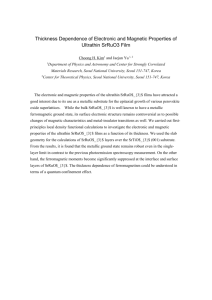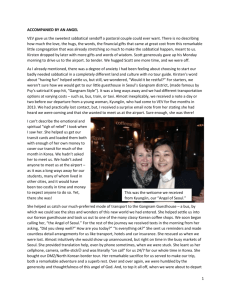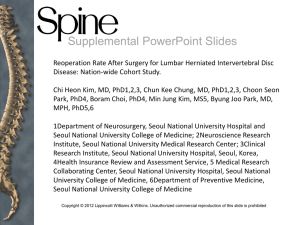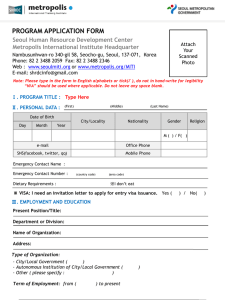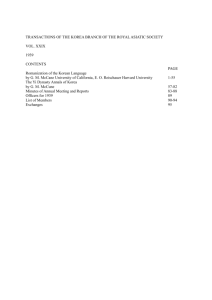CMS_Guide_Korean
advertisement
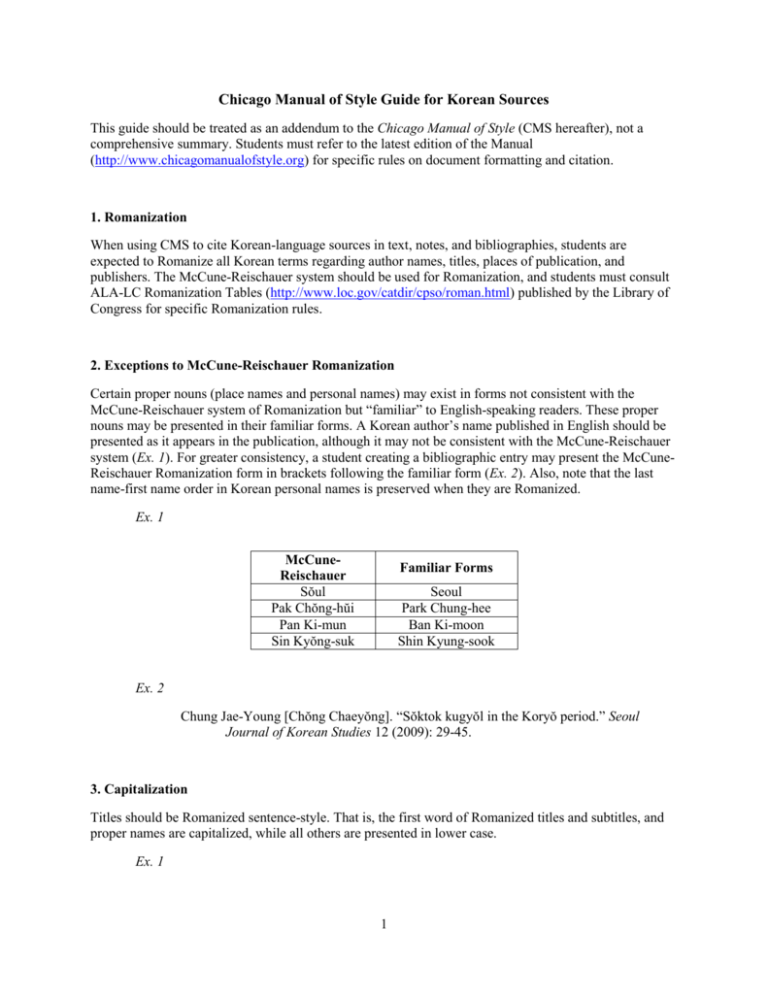
Chicago Manual of Style Guide for Korean Sources This guide should be treated as an addendum to the Chicago Manual of Style (CMS hereafter), not a comprehensive summary. Students must refer to the latest edition of the Manual (http://www.chicagomanualofstyle.org) for specific rules on document formatting and citation. 1. Romanization When using CMS to cite Korean-language sources in text, notes, and bibliographies, students are expected to Romanize all Korean terms regarding author names, titles, places of publication, and publishers. The McCune-Reischauer system should be used for Romanization, and students must consult ALA-LC Romanization Tables (http://www.loc.gov/catdir/cpso/roman.html) published by the Library of Congress for specific Romanization rules. 2. Exceptions to McCune-Reischauer Romanization Certain proper nouns (place names and personal names) may exist in forms not consistent with the McCune-Reischauer system of Romanization but “familiar” to English-speaking readers. These proper nouns may be presented in their familiar forms. A Korean author’s name published in English should be presented as it appears in the publication, although it may not be consistent with the McCune-Reischauer system (Ex. 1). For greater consistency, a student creating a bibliographic entry may present the McCuneReischauer Romanization form in brackets following the familiar form (Ex. 2). Also, note that the last name-first name order in Korean personal names is preserved when they are Romanized. Ex. 1 McCuneReischauer Sŏul Pak Chŏng-hŭi Pan Ki-mun Sin Kyŏng-suk Familiar Forms Seoul Park Chung-hee Ban Ki-moon Shin Kyung-sook Ex. 2 Chung Jae-Young [Chŏng Chaeyŏng]. “Sŏktok kugyŏl in the Koryŏ period.” Seoul Journal of Korean Studies 12 (2009): 29-45. 3. Capitalization Titles should be Romanized sentence-style. That is, the first word of Romanized titles and subtitles, and proper names are capitalized, while all others are presented in lower case. Ex. 1 1 『오백년기담』 Obaengnyŏn kidam Ex. 2 「식민지 조선에서의 검열의 사상과 방법」 “Singminji Chosŏn esŏ ŭi kŏmyŏl ŭi sasang kwa pangbŏp” 4. Translation of Titles When the title of a Korean-language work is mentioned in text, students should provide an English translation gloss in parentheses. If the original work has been translated into English and published, the English title of the published translation, in italics or quotation marks depending on the type of work, is capitalized headline-style and placed in the parentheses. If the English translation has not been published, a translation of the original title is capitalized sentence-style and placed in the parentheses without italics or quotation marks. The same rules apply in creating notes and bibliographies, except that translated titles are enclosed in brackets, instead of parentheses. Ex. 1 Shin Kyung-sook [Sin Kyŏng-suk]. Ŏmma rŭl put’akhae [Please Look After Mom]. P’aju: Ch’angbi, 2008. Ex. 2 Ch’ae Paek. “Kŭndae Minjokchuŭi ŭi hyŏngsŏng kwa kaehwagi ch’ulp’an” [Emergence of nationalism and publishing during the Enlightenment period in modern Korea]. Han’guk ŏllon chŏngbo hakpo 41 (2008): 7-40. 5. Inclusion of Korean Script (Han’gŭl) or Chinese Characters (Hanja) In order to facilitate identification of references and terms used, students may be asked to provide original terms in han’gŭl or hanja. In such cases, original terms are presented directly behind Romanized terms without parentheses, brackets, or quotation marks. Ex. 1 Han Paek-kyŏm 韓百謙. Tongguk chiri chi 東國地理志 [Geographic records of the Eastern Kingdom]. Seoul: Iljogak, 1982. Ex. 2 Han Sŭng-jun. “Yŏnghwa chiwŏn chŏngch’aek ŭi ideollogi kyŏnghyangsŏng yŏn’gu: yŏnghwa chinhŭng wiwŏnhoe rŭl chungsim ŭro” 영화지원정책의 이데올로기 경향성 연구: 영화진흥위원회를 중심으로 [Study on the ideological tendency of the government policy on film funding: Focusing on the Korean Film Council]. Haengjŏng nonch’ong 48, no. 2 (2010): 309-337. 2 6. Sample Notes and Bibliographic Entries A. Books One author Note 1. Pak Wan-sŏ, Urŭm sori 울음소리 [Sound of crying] (Seoul: Sol, 1996), 27. Bibliography Pak Wan-sŏ. Urŭm sori 울음소리 [Sound of crying]. Seoul: Sol, 1996. Two or more authors Note 1. Kwŏn Yŏng-min and Im Yŏng-hwan, Hyŏndai sosŏl ŭi kujo wa mihak 현대소설의 구조와 미학 [Structure and aesthetics of modern fiction] (Seoul: T’aehaksa, 2005), 25. Bibliography Kwŏn Yŏng-min and Im Yŏng-hwan. Hyŏndai sosŏl ŭi kujo wa mihak 현대소설의 구조와 미학 [Structure and aesthetics of modern fiction]. Seoul: T’aehaksa, 2005. Edited book Note 1. Yi Pyŏng-ju, Sŭp’ein naejŏn ŭi pigŭk 스페인 내전의 비극 [Tragedy of the Spanish Civil War], ed. Kim Chong-hoe and Kim Yun-sik (Seoul: Paibuksŭ, 2013), 30. Bibliography Yi Pyŏng-ju. Sŭp’ein naejŏn ŭi pigŭk 스페인 내전의 비극 [Tragedy of the Spanish Civil War]. Edited by Kim Chong-hoe and Kim Yun-sik. Seoul: Paibuksŭ, 2013. Article or chapter in an edited book Note 3 1. Chŏng Hae-ŭn, “Ponggŏn ch’eje ŭi tong’yo wa yŏsŏng ŭi sŏngjang” 봉건체제의 동요와 여성의 성장 [Wavering feudal society and the empowerment of women], in Uri yŏsŏng ŭi yŏksa 우리 여성의 역사 [History of our women], ed. Han’guk yŏsŏng yŏn’guso (Seoul: Ch’ŏngnyŏnsa, 1999), 237. Bibliography Chŏng Hae-ŭn. “Ponggŏn ch’eje ŭi tong’yo wa yŏsŏng ŭi sŏngjang” 봉건체제의 동요와 여성의 성장 [Wavering feudal society and the empowerment of women]. In Uri yŏsŏng ŭi yŏksa 우리 여성의 역사 [History of our women]. Edited by Han’guk yŏsŏng yŏn’guso, 225-250. Seoul: Ch’ŏngnyŏnsa, 1999. Book translated from Classical Chinese to Korean Note 1. Kim Si-sŭp, Kŭmo sinhwa 금오신화 [New tales from Gold Turtle Mountain], trans. Yi Chi-ha (Seoul: Minŭmsa, 2009). Bibliography Kim Si-sŭp. Kŭmo sinhwa 금오신화 [New tales from Gold Turtle Mountain]. Translated by Yi Chi-ha. Seoul: Minŭmsa, 2009. B. Journals One author Note 1. Pak Yu-hŭi, “Koliptoen chŏnsa, kyŏnggye ŭi t’aja: t’alnaengjŏn sidae han’guk chŏnjaeng yŏnghwa e nat’anan ‘puk’ ŭi p’yosang” 고립된 전사, 경계의 타자: 탈냉전시대 한국전쟁 영화에 나타난 “북”의 표상 [The isolated warrior, the alarming other: The representation of the “North” in post-Cold-War Korean War films], Minjok munhwa yŏn’gu 58 (2013): 771. Bibliography Pak Yu-hŭi. “Koliptoen chŏnsa, kyŏnggye ŭi t’aja: t’alnaengjŏn sidae han’guk chŏnjaeng yŏnghwa e nat’anan ‘puk’ ŭi p’yosang” 고립된 전사, 경계의 타자: 탈냉전시대 한국전쟁 영화에 나타난 “북”의 표상 [The isolated warrior, the alarming other: The representation of the “North” in post-Cold-War Korean War films]. Minjok munhwa yŏn’gu 58 (2013): 751-789. 4 Journal with two or more authors Note 1. Chŏng Chaeyŏng and Kim Sŏngju, “Yŏnggwang Pulgapsa pokchang chŏnjŏk e taehan kugŏhakchŏk yŏn’gu” 영광 불갑사 복장 전적에 대한 국어학적 연구 [A linguistic study of the texts recovered from a statue at the Yŏnggwang Pulgap Temple], Sŏjihakpo 35 (2010): 230. Bibliography Chŏng Chaeyŏng and Kim Sŏngju. “Yŏnggwang Pulgapsa pokchang chŏnjŏk e taehan kugŏhakchŏk yŏn’gu” 영광 불갑사 복장 전적에 대한 국어학적 연구 [A linguistic study of the texts recovered from a statue at the Yŏnggwang Pulgap Temple]. Sŏjihakpo 35 (2010): 207-251. Electronic journal articles Note 1. Sim Kyŏng-ho, “Munja wa maech’ae: Chosŏn sŏnbi ŭi munja saenghwal kwa chijŏk kyoryu” 문자와 매체: 조선선비의 문자생활과 지적 교류 [Writing and media: The literary activities and intellectual intercourse of Chosŏn Dynasty literati], Kukhak yŏn’gu 14 (2009): 424, http://www.dbpia.co.kr. ezproxy.library.ubc.ca/ Article/1078736. Bibliography Sim Kyŏng-ho. “Munja wa maech’ae: Chosŏn sŏnbi ŭi munja saenghwal kwa chijŏk kyoryu” 문자와 매체: 조선선비의 문자생활과 지적 교류 [Writing and media: The literary activities and intellectual intercourse of Chosŏn Dynasty literati]. Kukhak yŏn’gu 14 (2009): 413-449. http://www.dbpia.co.kr.ezproxy.library.ubc. ca /Article/1078736. C. Film DVDs Note 1. Kojijŏn 고지전 [The Front Line], directed by Chang Hun (2011; Seoul: KD Media, 2011), DVD. Bibliography 5 Kojijŏn 고지전 [The Front Line]. Directed by Chang Hun. 2011. Seoul: KD Media, 2011. DVD. Online Video Note 1. T’aebaek sanmaek 태백산맥 [The T’aebaek Mountains], directed by Im Kwŏn-t’aek (1994; Seoul: T’aehŭng, 1995), online video clip, https://www.youtube.com/user/ KoreanFilm Bibliography T’aebaek sanmaek 태백산맥 [The T’aebaek Mountains]. Directed by Im Kwŏn-t’aek. 1994. Seoul: T’aehŭng, 1995. Online video clip. https://www.youtube.com/ user/KoreanFilm/. 6
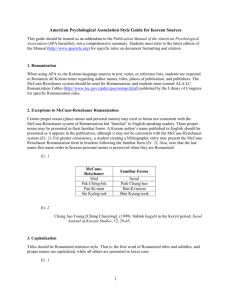

![[Slogan] Proposal for Seoul Brand Idea Contest](http://s3.studylib.net/store/data/006838769_1-d7653e11f28783f70bcf6bf0f4022941-300x300.png)
